Kia Niro: Hybrid Control System / Troubleshooting
Basic Inspection Procedure
Measuring Condition of Electronic Parts' Resistance
The measured resistance at high temperature after vehicle running may be high
or low. So all resistance must be measured at ambient temperature (20°C, 68°F),
unless stated otherwise.
|
The measured resistance in except for ambient temperature (20°C, 68°F)
is reference value.
|
Intermittent Problem Inspection Procedure
Sometimes the most difficult case in troubleshooting is when a problem symptom
occurs but does not occur again during testing. An example would be if a problem
appears only when the vehicle is cold but has not appeared when warm. In this case,
the technician should thoroughly make out a "Customer Problem Analysis Sheet" and
recreate (simulate) the environment and condition which occurred when the vehicle
was having the issue.
| 1. |
Clear Diagnostic Trouble Code (DTC).
|
| 2. |
Inspect connector connection, and check terminal for poor connections,
loose wires, bent, broken or corroded pins, and then verify that the connectors
are always securely fastened.
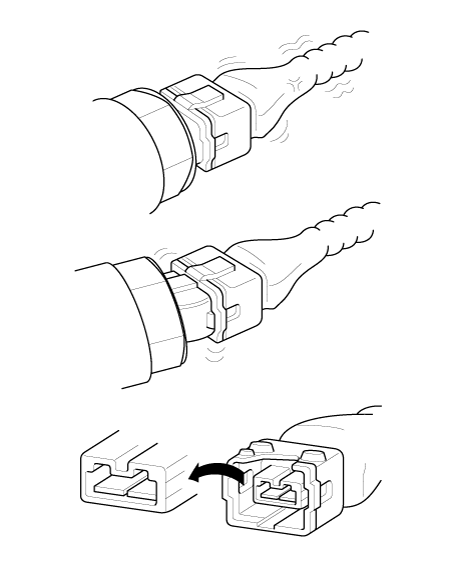
|
| 3. |
Lightly shake the connector and wiring harness vertically and horizontally.
|
| 4. |
Repair or replace the component that has a problem.
|
| 5. |
Conduct a road test to verify that the problem has been resolved.
|
● Simulating Vibration
| a. |
Sensors and Actuators
: Lightly shake the sensors, actuators or relays by finger.
|
Strong vibration may break sensors, actuators or relays
|
|
| b. |
Connectors and Harness
: Lightly shake the connector and wiring harness vertically and then
horizontally.
|
● Simulating Heat
| a. |
Heat components suspected of causing the malfunction with a hair dryer
or other heat source.
| •
|
DO NOT heat components to the point of damaging them.
|
| •
|
DO NOT heat the ECM directly.
|
|
|
● Simulating Water Sprinkling
| a. |
Sprinkle water onto vehicle to simulate a rainy day or a high humidity
condition.
|
DO NOT sprinkle water directly into the engine compartment or
electronic components.
|
|
● Simulating Electrical Load
| a. |
Turn on all electrical systems to simulate excessive electrical loads
(Radios, fans, lights, rear window defogger, etc.).
|
Connector Inspection
Procedure
| 1. |
Handling of Connector
| a. |
Never pull on the wiring harness when disconnecting connectors.
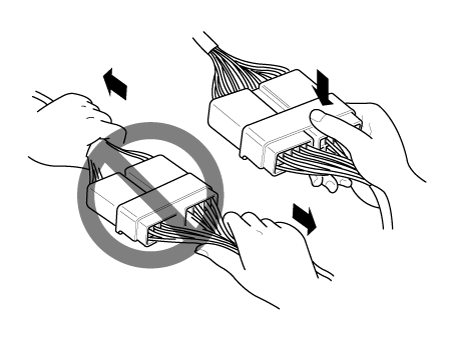
|
| b. |
When removing the connector with a latch, press or pull locking
lever.
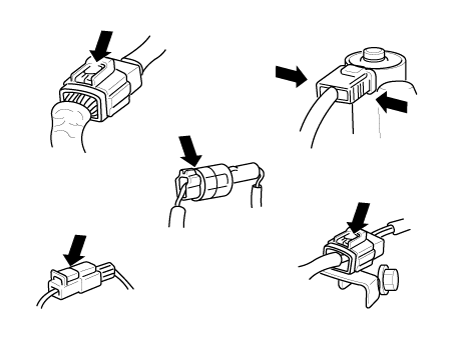
|
| c. |
Listen for a click when locking connectors. This sound indicates
that they are securely locked.
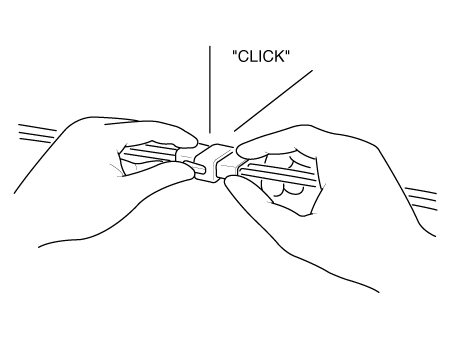
|
| d. |
When a tester is used to check for continuity, or to measure
voltage, always insert tester probe from wire harness side.
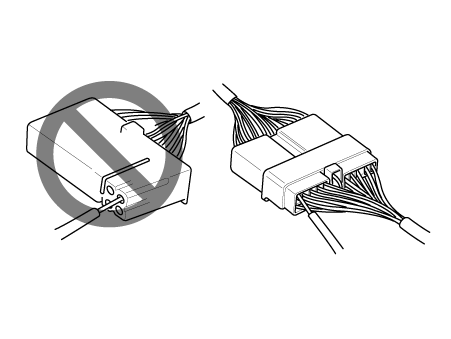
|
| e. |
Check waterproof connector terminals from the connector side.
Waterproof connectors cannot be accessed from harness side.
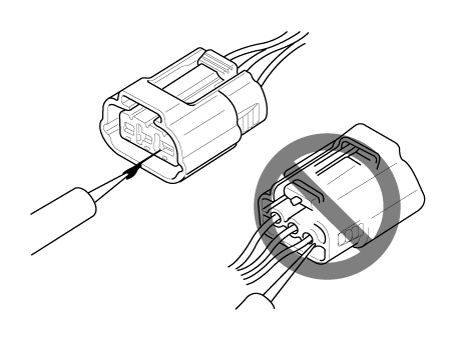
|
• |
Use a fine wire to prevent damage to the terminal.
|
|
• |
Do not damage the terminal when inserting the
tester lead.
|
|
|
|
| 2. |
Checking Point for Connector
| a. |
While the connector is connected:
Hold the connector, check connecting condition and locking efficiency.
|
| b. |
When the connector is disconnected:
Check missed terminal, crimped terminal or broken core wire by
slightly pulling the wire harness.
Visually check for rust, contamination, deformation and bend.
|
| c. |
Check terminal tightening condition:
Insert a spare male terminal into a female terminal, and then
check terminal tightening conditions.
|
| d. |
Pull lightly on individual wires to ensure that each wire is
secured in the terminal.
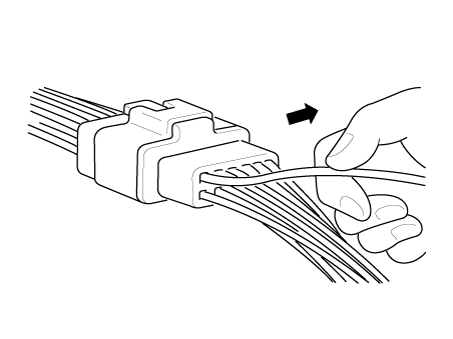
|
|
| 3. |
Repair Method of Connector Terminal
| a. |
Clean the contact points using air gun and/or shop rag.
|
Never use sand paper when polishing the contact points,
otherwise the contact point may be damaged.
|
|
| b. |
In case of abnormal contact pressure, replace the female terminal.
|
|
Wire Harness Inspection
Procedure
| 1. |
Before removing the wire harness, check the wire harness position and
crimping in order to restore it correctly.
|
| 2. |
Check whether the wire harness is twisted, pulled or loosened.
|
| 3. |
Check whether the temperature of the wire harness is abnormally high.
|
| 4. |
Check whether the wire harness is rotating, moving or vibrating against
the sharp edge of a part.
|
| 5. |
Check the connection between the wire harness and any installed part.
|
| 6. |
If the covering of wire harness is damaged; secure, repair or replace
the harness.
|
Electrical Circuit
Inspection Procedure
● Check Open Circuit
| 1. |
Procedures for Open Circuit
If an open circuit occurs (as seen in [FIG. 1]), it can be found by performing
Step 2 (Continuity Check Method) or Step 3 (Voltage Check Method) as shown
below.
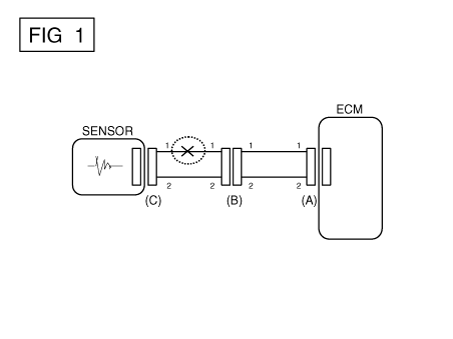
|
| 2. |
Continuity Check Method
|
When measuring the resistance, lightly shake the wire harness
vertically and horizontally..
|
|
Specification (Resistance)
1Ω or less → Normal Circuit
1MΩ or Higher → Open Circuit
|
| a. |
Disconnect connectors (A) and (C), and measure the resistance
between connectors (A) and (C) as shown in [FIG. 2].
In [FIG. 2], the measured resistances of lines 1 and 2 are higher
than 1MΩ and below 1 Ω respectively. Specifically, an open circuit
is in line 1. (Line 2 is normal.) To find the exact broken point,
check sub line of line 1 as described in the next step.
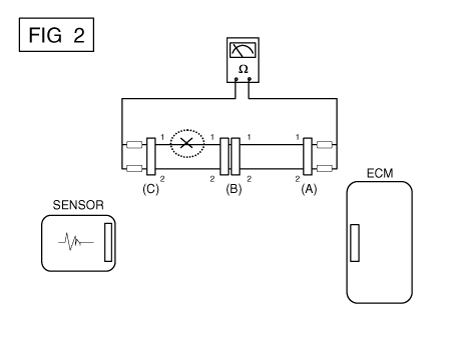
|
| b. |
Disconnect connector (B), and measure the resistances between
connectors (C) and (B1) and between (B2) and (A) as shown in [FIG.
3].
In this case the measured resistance between connector (C) and
(B1) is higher than 1MΩ and the open circuit is between terminal
1 of connector (C) and terminal 1 of connector (B1).
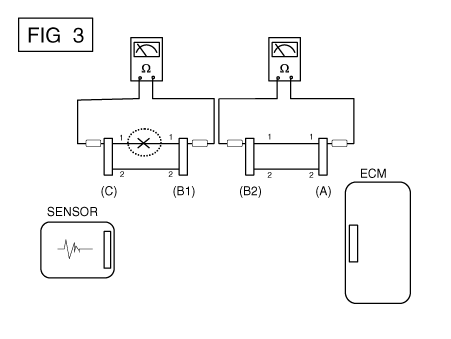
|
|
| 3. |
Voltage Check Method
| a. |
With each connector still connected, measure the voltage between
the chassis ground and terminal 1 of each connectors (A), (B) and
(C) as shown in [FIG. 4].
The measured voltages of each connector are 5V, 5V and 0V respectively.
So the open circuit is between connectors (C) and (B).
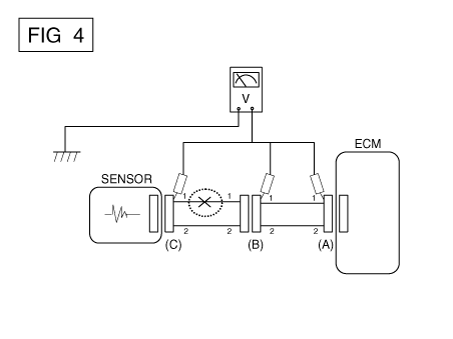
|
|
● Check Short Circuit
| 1. |
Test Method for Short to Ground Circuit
| • |
Continuity Check with Chassis Ground
|
If short to ground circuit occurs as shown in [FIG. 5], the broken point
can be found by performing Step 2 (Continuity Check Method with Chassis
Ground) as shown below.
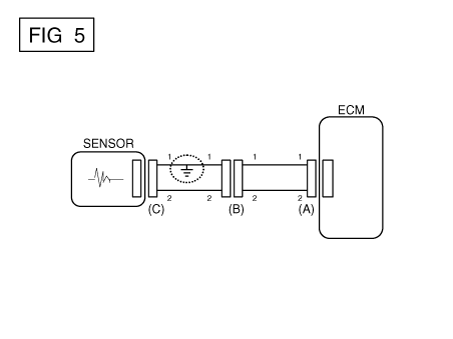
|
| 2. |
Continuity Check Method (with Chassis Ground)
|
Lightly shake the wire harness above and below, or from side
to side when measuring the resistance.
|
|
Specification (Resistance)
1Ω or less → Short to Ground Circuit
1MΩ or Higher → Normal Circuit
|
| a. |
Disconnect connectors (A) and (C), and measure the resistance
between connector (A) and Chassis Ground as shown in [FIG. 6].
The measured resistances of lines 1 and 2 in this example are
below 1 Ω and higher than 1 MΩ respectively. Specifically, a short
to ground circuit is in line 1. (Line 2 is normal.) To find the
exact broken point, check the sub line of line 1 as described in
the following step.
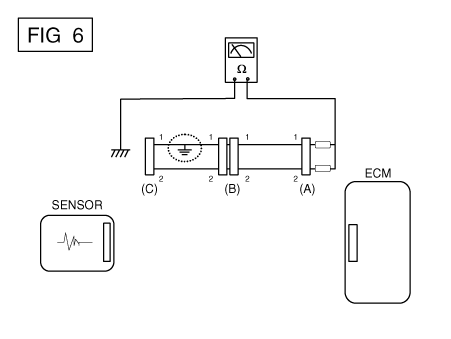
|
| b. |
Disconnect connector (B), and measure the resistance between
connector (A) and chassis ground, and between (B1) and chassis ground
as shown in [FIG. 7].
The measured resistance between connector (B1) and chassis ground
is 1Ω or less. The short to ground circuit is between terminal 1
of connector (C) and terminal 1 of connector (B1).
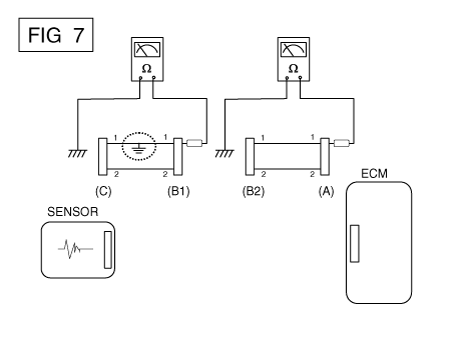
|
|
Procedure for entering engine
forced activation mode
If the engine needs to be run constantly while the vehicle is stopped to inspect
emission gas or perform maintenance on the vehi ...
Specification
Hybrid Control System
Hybrid Power Control
Unit (HPCU)
Item
Specification
Operating Voltage (V)
204 - ...
 Inspection mode procedures
Inspection mode procedures Specifications
Specifications















